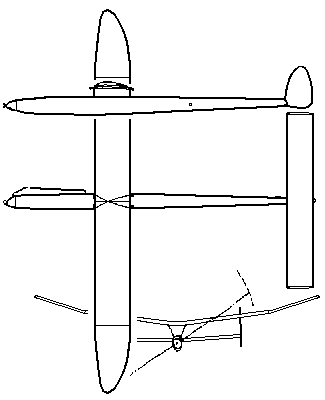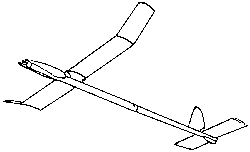Wakefield International Cup - A history from 1911 by Charles Dennis Rushing
1958 R S Bond Baker, 32, Australia
Now that the Wakefield Cup Rules had been completely "modernized" in 1957(the ROG and the cross section requirements having been deleted) there appeared a new species of Wakefield on the Continent. This new typology was especially originated by the innovative aeromodel designs of George Benedek, of Hungary. Even the most disinterested Wakefield observer will agree that Benedek's 1958 design was the 'leit motif' of the very same designs still prevalent today. The question is, why did it take so long for this typology to be recognized? The answer is of course conservatism, and tradition, especially in the USA, where nothing even remotely resembling the new typology appeared until the late 1970's. I don't mind an argument on this subject, because even casual research failed to produce a single example of the new typology in American design, and as a result the Americans fell into a period of moribund Wakefield design. Yes I know that the USA won another Wakefield Cup in 1961, but be objective, and compare Reich's Wakefield to Benedek's. Beyond the emotional attachment to the Traditional Era, or even the attachment to the Vintage Era, that still lingered in 1986 with Martyn Pressnell, Benedek had simply broken the mold, and had leapt into the future, and very few Wakefield innovators picked up on the change until it was way too late. From 1961 until 1987 is 26 years of groping without positive results. By than we would see another American Wakefield Champion, but also a rules change, that impacted like a bomb on the aged society of American Wakefield flyers, and made everything they were flying, totally obsolete.
"Future Shock" set in, and it is a painful admission for me to confess that the deletion of the "Builder of the Model Rule", caused the obsolescence, and forced new innovators to buy into the East European technological revolution. By 1995 the Eastern European production of Wakefield parts, and even whole aeromodels ready to fly, was an in-place cottage industry that cranked out enough products to supply the entire Wakefield community, world wide, numbering less than one thousand., with a totally new kind of Wakefield. Grandfathers were now being extolled in Model Aviation in January 1995 for "giving away their obsolete Wakefields to their grandchildren, or to their aged friends' grandchildren, so that they could fly them in the junior class"! The purchase of a new Wakefield, was no different a change for them than it was to switch their "1947 RCA Victrolla" for a "Sony Surround Sound Digital TV", and almost the same price. Unfortunately the mere purchase of technology doesn't mean that the buyer is up to date with technological innovation, because they may have only purchased an already obsolete anomaly. Wakefields now were being viewed by their purchasers, with the same apprehension as they had with the"black box' technology that surrounds them, "... what makes it fly like that?" The spectre of an anomaly haunted some of the young American Wakefield innovators in Sacramento, California, and they quietly set themselves to the task of designing a better solution than they could purchase; I will pick up this subject again in later chapters.
Back to Cranfield Aerodrome, north of London, again, after a one year, void in the previous WC format of Glider, Power, and Wakefield, came only Power and Wakefield. Nordic Glider held its own event in 1957, without the rest, and stayed away here. Wakefield Day was scheduled for Monday August 4, 1958. This year there were 73 contestants, from 22 nations to compete for the Wakefield International Cup.
ROUND 1 TO 4: The Team from Hungary, were being watched with trepidation, George Benedek, famed for his airfoil development, was in the lead with three 180 second maximums. Benedek flew a Wakefield like no other seen before, it was "minimalist" to use a term to describe modern art. It had a high aspect ratio wing configuration, with tip dihedral. A round tubular fuselage of a little more than one inch diameter, and a tapered tubular boom with a combined length of about fifty inches, with a moment arm of about thirty-one and one half inches. The nose moment was only eleven inches, barely enough to receive the propeller blades when they folded. The stabilizer was small, about seventeen percent of the wing area, and the rudder was smaller than usual too. At the launch, Benedek ran forward and javelened his Wakefield into the air with a throw that would have folded the wings of a conventional configuration. The Hungarian Team Manager was unconventional also, not there just to light dethermalizer fuses, his command was the law! He ordered the next Team Member he selected to wind up their Wakefield, and to prepare to launch on his command! It was a display of military discipline!
Team Italy was scoring maximums also, and by round two they had closed to within 9 seconds of the Hungarian Team. This give and take ended in round 4 when Benedek was down in 173 seconds, but the weather changed , and it began to rain at the end of round 4. The leader board does not lie:
| 1 | Benedek | Hungary | 713 |
| 2 | Scardicchio | Italy | 681 |
| 3 | Heimuller | Germany | 680 |
| 4 | Baker | Australia | 680 |
| 5 | Zurad | Poland | 656 |
 ".... we'll wait a while, mate"Only 56 seconds separated first and fifth places, and it was still raining. A great deal was being made of the Hungarian Team, and of Benedek in particular, he could win the Cup! Now the Hungarian Team Manager, with the bearing of a military commander, ordered Benedek to wind up, and than ordered him to launch! Obviously this damnable English weather would never improve! Launch, damn it, Launch! It was away! Climbing well, but of course, into cooling air. Benedek's Wakefield was down in 100 seconds, well now...! Across the line, and down field, was the 1954 Wakefield Champion, working with Bond Baker, they were alone, Alan was Team Australia's Manager, and what he did counted. He reached over and snuffed out Bonds DT fuse, and said "...we'll wait awhile Mate..." Overhead there came a break in the cloud cover, all across the Bedfordshire country side. As a line of sunshine began to dart toward the flight line, Alan told Bond to start winding. Bond Baker packed the turns into the rubber motor, fitted the noseblock into place, and Alan King lit the DT fuse, set to burn for three minutes "... all it would take to win this show, Mate." Now Bond was ready, holding his Wakefield at a steep angle, he threw it into the building air. As Bond's Wakefield climbed the sun burst through the cloud cover, and lit up the scene below, passing sun glow on the apprehensive face of the Hungarian Team Manager, whose thoughts were, we shall never know. Bond's Wakefield continued to climb for one minute, transitioning into a left glide at about 300 feet of altitude, and climbed up for a perfect 180, before dethermalizing. The final leader board looked like this:
".... we'll wait a while, mate"Only 56 seconds separated first and fifth places, and it was still raining. A great deal was being made of the Hungarian Team, and of Benedek in particular, he could win the Cup! Now the Hungarian Team Manager, with the bearing of a military commander, ordered Benedek to wind up, and than ordered him to launch! Obviously this damnable English weather would never improve! Launch, damn it, Launch! It was away! Climbing well, but of course, into cooling air. Benedek's Wakefield was down in 100 seconds, well now...! Across the line, and down field, was the 1954 Wakefield Champion, working with Bond Baker, they were alone, Alan was Team Australia's Manager, and what he did counted. He reached over and snuffed out Bonds DT fuse, and said "...we'll wait awhile Mate..." Overhead there came a break in the cloud cover, all across the Bedfordshire country side. As a line of sunshine began to dart toward the flight line, Alan told Bond to start winding. Bond Baker packed the turns into the rubber motor, fitted the noseblock into place, and Alan King lit the DT fuse, set to burn for three minutes "... all it would take to win this show, Mate." Now Bond was ready, holding his Wakefield at a steep angle, he threw it into the building air. As Bond's Wakefield climbed the sun burst through the cloud cover, and lit up the scene below, passing sun glow on the apprehensive face of the Hungarian Team Manager, whose thoughts were, we shall never know. Bond's Wakefield continued to climb for one minute, transitioning into a left glide at about 300 feet of altitude, and climbed up for a perfect 180, before dethermalizing. The final leader board looked like this:
| Place | Name | Country | Total |
| 1 | R S B Baker | AUS | 860 |
| 2 | S Zurad | POL | 824 |
| 3 | R Johansson | SWE | 819 |
| 4 | V Scardicchio | ITA | 817 |
| 5 | G Benedek | HUN | 813 |
| 6 | D R Kennedy | NZL | 809 |
| 7 | G Fea | ITA | 793 |
| 8 | G Lefever | GBR | 764 |
| 9 | L Azor | HUN | 763 |
| 10 | A Gordon | IRL | 757 |
Bond Baker, of Australia was the 1958 Wakefield World Champion. Team Hungary won the Alphonse Penaud Cup as the winning Team. Team USA despite having such veterans as: Herb Kothe, a Team Member in 1955, and 1956, George Reich, who was fourth on the 1953 Team, Sal Cannizzo, and F A Newquist, did no better this time than: 15, 28, 46, and 60th places. Picking air in the rounds, was the problem, luck may have been absent also. For John O'Donnell of Team UK, luck slammed the door in his face when, under full winds, he watched helplessly, as his Wakefield, climbed up, and his feathering propeller disintegrated, clocking in at 8 seconds in round two.


References
Future Shock, fiction, Elvis Tombler
1957 FAI/CIAM Sporting Code 1984 NFFS Symposium
M.A.N. Dec 1958, 1958 W.C., Peter G F Chinn
1959-61 Model Aeronautics Year Book, Frank Zaic
Music: "West Side Story"; Literature: "On The Road"; Cine: "The Bridge over the River Kwai"
